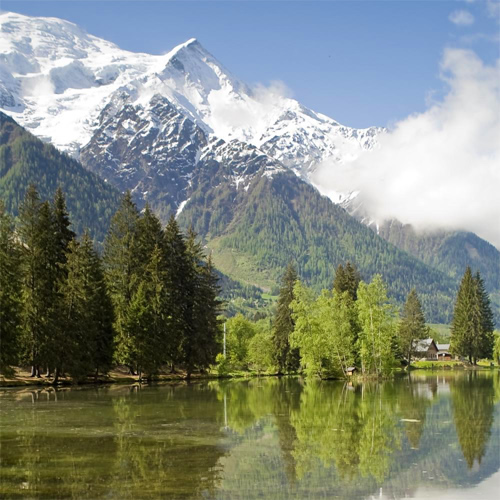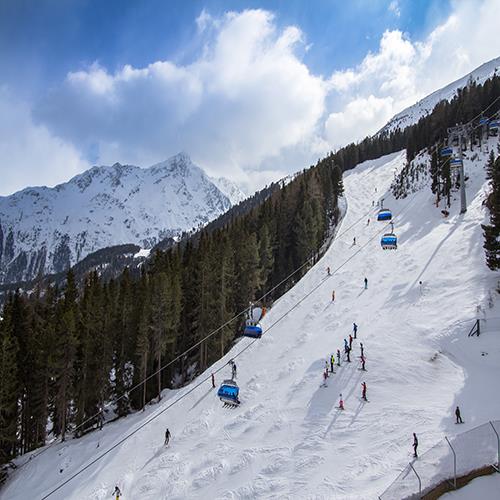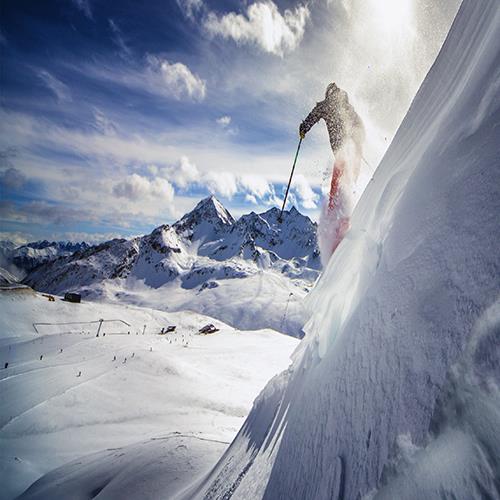EXPERIENCE CHAMONIX

Overview
Chamonix, located in southeastern France at the foot of Mont Blanc, just a short hop to Switzerland and Italy, is one of the world’s finest ski resorts, thanks to its vast array of lift-accessible off-piste terrain, four diverse ski areas, and Europe’s highest peak, Mont Blanc. Grands Montets, Brévent-Flégere, Domaine de Balme, and Les Houches all offer freestyle, free-ride, and tracked terrain. When the sun sets behind the ragged peaks, bars and clubs pulse to live music and talk of mountainous adventures. When summer comes around, the resort is popular with climbers, bikers, and hikers keen to take advantage of the stunning natural scenery.


Mont Blanc
Mont-Blanc is the highest peak of the Alps and forms part of the French border with Italy. Soaring to an altitude of 15,780 ft, Mont Blanc is always covered in snow, explaining why it's called the "White Mountain."
Also referred to as “the Road of Europe” it offers stunning viewpoints of the Aiguilles Rouges mountain ranges and Chamonix Valley. It’s also one of the best ski areas in all of France. Visitors come here not only to ski, but to admire the Alpine landscapes on numerous hiking trails or by taking one of the gondola lifts.
The Tour du Mont-Blanc hiking trails offer routes for all ability levels, from gentle walks and intermediate hikes to treks up vigorous terrain, and has a reputation of having some of the best hiking in the world. The scenery is breathtaking boasting photo-ops at every angle. Along the way, traditional Alpine huts and chalets provide refreshments, meals, and overnight accommodations.
Experienced climbers with a guide are able to climb to the top of Mont Blanc, although it is grueling. From Les Houches, the climb takes 10 to 12 hours. The most common climbing route is through the Aiguille du Goûter and the Arête des Bosses.

Chamonix Village
The Chamonix village offers a mix of traditional Alpine architecture with some modern buildings mixed in. At the center of town there is a pedestrian area that boasts a lovely Baroque church. Dotted around Chamonix are old-fashioned chalets and Belle Epoque hotels, as well as rustic country lodges.
The village is lively with tourist shops, high-end boutiques, and gourmet restaurants. Dining options vary from casual cafés and traditional brasseries to fancy gastronomic establishments. For an authentic experience, try the regional cuisine at a welcoming auberge or mountain refuge.
Many charming boutique hotels, as well as classic historic hotels are located right in the village of Chamonix. Staying in the village area allows for easy access to fantastic restaurants, cafes, and shops, as well as the Aiguille du Midi cable car and the Brévent gondola.



Tramway du Mont Blanc
The Tramway du Mont Blanc offers a chance to appreciate the area's stunning Alpine landscape. The tramway departs from Le Fayet or Saint-Gervais-les-BainsOutdoor enthusiasts can embark on trails for taking nature walks, hikes, or mountain bike rides from the tramway’s drop-off point. During the summer, the highest dop-off point (Nid d’Aigle) is open.
The tramway departs from Le Fayet or Saint-Gervais-les-Bains. The train has two stops: Bellevue and Nid d'Aigle. Tourists are awed by extensive views of Mont Blanc, as well as other mountain peaks, Alpine pastures, and expansive forests as the tramway ascends to Bellevue at 5,905 ft.
At Bellevue, visitors mcan enjoy a scenic walk around the verdant Bellevue plateau. True to its name, Bellevue features beautiful views, and it also has an stylish mountain restaurant with good food and an enjoyable atmosphere. From Bellevue, there are easy walks through a valley and Alpine meadows, as well as trails that lead to the hamlets of Les Houches.
During summertime, visitors may continue up the summit by taking the tramway ride to the Nid d'Aigle at 7,782 ft, which offers breathtaking views of the landscape. A scenic walking path leads from the Nid d'Aigle to the Bionnassay Glacier.
From June through September, the modern Refuge du Nid d’Aigle mountain hut offers overnight accommodations, a basic dormitory type overnight stay. A bit higher up, the Refuge de Tête Rousse offers "base camp" tents and dormitory accommodations with a half-board meal option.
The Nid d'Aigle lies under the rugged Aiguille du Goûter mountain peak (where mountaineers set out for their climb of Mont Blanc). En route to the summit of Mont Blanc at 12,516 ft (the highest elevation of any hotel in France), the Refuge du Gouter mountain hut provides mountain climbers with meals and lodging.



Skiing
The Chamonix Valley is considered by many to be the best freeride resort in the world. With its 5 ski resorts (Grands Montets, Les Houches, Le Tour/Balme, La Flegere and Le Brevent) Chamonix Mont-Blanc offers an excellent ski get-away.
Out of the several distinct sectors of ski area, two are located with direct access from Chamonix, the rest being a short drive further up and down the valley.
Close to the resort center, a spectacular two stage cable-car takes you to the top of the Aiguille du Midi, where you can get up close and personal with the peaks and glaciers of Mont Blanc. This is also the start of the 13.5-mile Vallée Blanche route - perhaps the most famous off-piste ski run in the world. Note that there are no marked or patrolled pistes in this area, so a guide is essential.
The only other major ski area accessible from town is Le Brévent, a steep walk or short drive from the town center. Le Brévent is linked to the La Flégère sector, which is also accessible by cable-car about a mile up the valley.
These two areas offer a good variety of open slopes with excellent views of Mont Blanc but from which, depending on snow conditions, you sometimes have to take a lift back down to the valley.
The most famous ski mountain in the Chamonix area is Les Grand Montets, 5.5-miles up the valley above the traditional village of Argentière.Not only does this area offer the toughest skiing that Chamonix has to offer (both on and off-piste), but it also frequently has the best snow.
Beyond Argentière, at the north-eastern end of the valley, is the small village of Le Tour, whose skiing offers a gentler mix of open bowls and woodland glades which are also linked to another village, Vallorcine.
On the other side of Chamonix at the south-western end of the valley is the Les Houches sector, home to the Kandahar world cup downhill. This is a good area for mixed abilities, with most of the easier skiing higher up, and some longer, steeper runs through the trees back to resort.
Depending on your level of proficiency, consider hiring a mountain guide to help navigate the ski mountains in the Alps.

Summer Activities
there’s no shortage of things to do in Chamonix in the summer and no absence of adventure. In lieu of snow and ice you’ve got colorful wildflowers and wildlife galore, green mountains, glacial waterfalls, sunshine, and a whole list of interesting things to do that you can only do in the summer.
Chamonix in the summer offers the perfect conditions for outdoor activities such as hiking, biking, paragliding, climbing, rafting, and tons more. The weather is great with lots of sunshine and warmth during the day, but you still get to experience the coziness of the Alps after the sun goes down.

Rock Climbing at Rochers des Gaillands
Many extreme mountain climbers aspire to climb the granite rock face at Chamonix. There are extremely challenging mountain climbing routes along the north faces as well as boulders for amateur climbers and beginners.
About 1.5-miles south of Chamonix next to the Gaillands Lake, the Rochers Gaillands offer a range of climbing routes from easy to difficult. The legendary mountaineer, Roger Frison-Roche, created the first mountain climbing school at Les Gaillands in 1936.